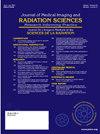3D-Printing Service in Radiology: Emerging Technology and Point-of-Care Innovations for Efficient, Personalized Medical Care and Precise Treatment Planning
IF 2
Q3 RADIOLOGY, NUCLEAR MEDICINE & MEDICAL IMAGING
Journal of Medical Imaging and Radiation Sciences
Pub Date : 2025-07-01
DOI:10.1016/j.jmir.2025.102052
引用次数: 0
Abstract
Aim
.
Background
3D printing is revolutionizing medicine by enabling the creation of patient-specific anatomical models, enhancing visualization, and advancing precision in medical care. This emerging technology, combined with the establishment of an in-house 3D printing centre, expands radiology’s role as a point-of-care service, facilitating faster and more personalized treatment planning.
Objective
To explore the transformative impact of 3D printing as an emerging technology in radiology, highlighting its role in customizing patient care and demonstrating how in-house capabilities improve the precision, efficiency and effectiveness of healthcare services.
Methods
This presentation examines the integration of 3D printing into treatment planning across various medical conditions. Key applications include the creation of advanced training models that allow surgeons to refine their skills for complex procedures and the development of patient-specific surgical guides that enhance intraoperative precision. Rapid prototyping was employed for urgent cases such as orbital wall fractures and pelvic pathologies, ensuring timely and accurate surgical planning. Virtual surgical planning, combined with specialized software and real-time collaboration with on-site engineers further streamlined processes, significantly improving precision and saving valuable time. Additionally, advancements in DIEP flap model printing, adapted from insights gained during HMDP training at Stanford Medicine Hospital, demonstrated the value of iterative improvements based on direct surgeon feedback.
Results
The use of 3D-printed training models significantly boosted surgeons’ confidence before surgery. The availability of an in-house 3D printing centre reduced model production time by 40%, facilitating rapid prototyping for urgent cases. Direct collaboration between surgeons and engineers allowed real-time adjustments to surgical guides, enhancing accuracy and efficiency. Virtual surgical planning and customized 3D models enhanced surgeons’ understanding of complex patient’s anatomical structures in 85% of cases. This innovation results in a more precise and effective treatment planning, setting a new level for individualized and efficient patient care.
Conclusion
3D printing stands at the forefront of medical revolution, reshaping healthcare by combining innovative and cutting-edge tools with point-of-care solutions. This enables in delivering a faster, more personalized medical care and precise treatment planning. The establishment of an in-house 3D printing centre exemplifies this transformation, enhancing radiology’s role in improving efficiency, accuracy, and the overall quality of patient care.
放射学中的3d打印服务:用于高效、个性化医疗护理和精确治疗计划的新兴技术和护理点创新
目标。3d打印通过创建患者特定的解剖模型,增强可视化和提高医疗保健的精度,正在彻底改变医学。这项新兴技术与内部3D打印中心的建立相结合,扩大了放射学作为即时护理服务的作用,促进了更快、更个性化的治疗计划。目的探讨3D打印作为一项新兴技术在放射学中的变革性影响,突出其在定制患者护理方面的作用,并展示内部能力如何提高医疗保健服务的准确性、效率和有效性。方法:本报告探讨了将3D打印整合到各种医疗条件的治疗计划中。关键应用包括创建先进的培训模型,使外科医生能够完善复杂手术的技能,以及开发针对患者的手术指南,提高术中精度。对于眶壁骨折、盆腔病变等急诊病例,采用快速成型技术,确保手术计划及时准确。虚拟手术计划,结合专业软件和与现场工程师的实时协作,进一步简化了流程,显着提高了精度并节省了宝贵的时间。此外,根据斯坦福医学院HMDP培训期间获得的见解,DIEP皮瓣模型打印的进步证明了基于外科医生直接反馈的迭代改进的价值。结果3d打印训练模型的使用显著提高了外科医生在手术前的信心。内部3D打印中心的可用性将模型生产时间缩短了40%,促进了紧急情况下的快速原型制作。外科医生和工程师之间的直接协作允许实时调整手术指南,提高准确性和效率。在85%的病例中,虚拟手术计划和定制的3D模型增强了外科医生对复杂患者解剖结构的理解。这一创新导致了更精确和有效的治疗计划,为个性化和高效的患者护理设定了一个新的水平。结论3d打印站在医疗革命的前沿,通过将创新和尖端工具与护理点解决方案相结合,重塑医疗保健。这使我们能够提供更快、更个性化的医疗护理和精确的治疗计划。内部3D打印中心的建立体现了这种转变,增强了放射学在提高效率、准确性和患者护理整体质量方面的作用。
本文章由计算机程序翻译,如有差异,请以英文原文为准。
求助全文
约1分钟内获得全文
求助全文
来源期刊

Journal of Medical Imaging and Radiation Sciences
RADIOLOGY, NUCLEAR MEDICINE & MEDICAL IMAGING-
CiteScore
2.30
自引率
11.10%
发文量
231
审稿时长
53 days
期刊介绍:
Journal of Medical Imaging and Radiation Sciences is the official peer-reviewed journal of the Canadian Association of Medical Radiation Technologists. This journal is published four times a year and is circulated to approximately 11,000 medical radiation technologists, libraries and radiology departments throughout Canada, the United States and overseas. The Journal publishes articles on recent research, new technology and techniques, professional practices, technologists viewpoints as well as relevant book reviews.
 求助内容:
求助内容: 应助结果提醒方式:
应助结果提醒方式:


